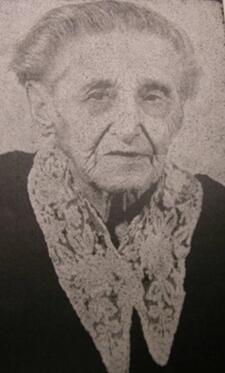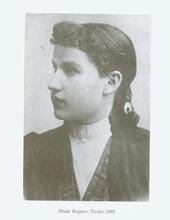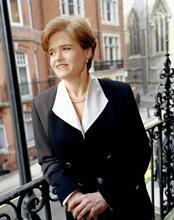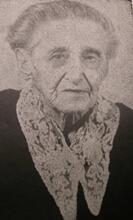Zionism in Galicia and Poland, 1880-1939
Prior to World War I, few women joined Zionist organizations in Russian Poland, though Galician women did start joining the movement through independent women’s organizations such as Devora and Miriam. After the unification of Poland, more and more women joined Zionist organizations. A branch of the Women’s International Zionist Organization was founded in Poland in 1927 and became the biggest branch in the diaspora. Women also joined socialist Zionist groups and Hechalutz in droves, though the leadership of these groups still remained all male. Groups like Hechalutz declared a belief in gender equality, but women were often assigned traditional jobs like laundry and cooking in Hechalutz training camps. Despite this, these groups often provided opportunities for women to significantly advance their lives.
Women and the Zionist Movement in Poland, 1882-1939
Prior to the late 19th century, women were almost absent from Jewish public and religious life in Congress Poland (Russian Poland or the Kingdom of Poland, which was under Russian authority from 1815 to 1915) and the province of Galicia (which was part of the Habsburg Empire from 1772 to 1918). Only toward the end of the century did women become more visible in Jewish life in these areas, as a result of changes in lifestyle across Eastern Europe. The rise in the average age of marriage significantly increased the number of young Jewish women from the middle class who studied at gymnasium [high school] and university. At the same time, many young women from poorer milieus left their families and moved to big cities, where they lived on their own and came in contact with new ideas and ideologies. As a result, at the end of the nineteenth and in the early twentieth centuries, Jewish women joined socialist parties and revolutionary movements in significant numbers. But although they were involved in Zionism in its nascent years, women were not part of the Zionist leadership in either Congress Poland or Galicia.
Congress Poland 1882-1914
Until World War I, Zionist activity in Congress Poland falls under the rubric of Russian Zionist activities. During the period of proto-Zionism, between the early 1880s and 1897, several dozen local Lit. "love of Zion." Movement whose aim was national renaissance of Jews and their return to Erez Israel. Began in Russia in 1882 in response to the pogroms of the previous year. Led to the formation of Bilu, the first modern aliyah movement.Hibbat Zion (Lover of Zion) associations were founded in Congress Poland as well as across Russia. In addition to supporting the Jewish settlements created in Palestine at the beginning of 1880s, members of Hibbat Zion studied the Hebrew language and nurtured Hebrew literature and culture. Between 1882 and 1897, women formed separate associations, called Benut Zion (daughters of Zion), in various parts of the Russian Empire, including Congress Poland. As with Hibbat Zion, the members mostly studied Hebrew language, Bible, and Jewish history. Young women from the lower social classes conducted their activities in Yiddish, women from the middle class in Polish or Russian. In 1894, the Benut Zion association in Vilnius established a Hebrew-language school for girls, as well as a library where young women could borrow books. Similar activities took place across Congress Poland.
Nevertheless, Benut Zion organizations were not represented at the Hibbat Zion gatherings that took place in Katowice in November 1884, Druskieniki in July 1887, and Vilna in August 1889. Jewish women’s Zionist associations also were not represented on Hibbat Zion’s executive committee (Odessa Committee), founded after Zionist activity became legal in the Russian Empire in April 1890. Several members of the Odessa Committee, wanting to guarantee cooperation between Orthodox and non-Orthodox leaders and members of Hibbat Zion, refused to grant the female members of Benut Zion associations the recognition they deserved. Even the Bnei Moshe (Children of Moshe) association, a secular Zionist association, closed its doors to women.
After the official establishment of the international Zionist movement in 1897, women continued to be involved in Zionist activities in Congress Poland, as well as in other parts of the Russian Empire, without the recognition they deserved. Among the 250 official representatives of the first Zionist Congress who gathered in Basel in August 1997, only twelve were women, and none of these were from Congress Poland. The few women from Congress Poland who attended this Congress were family members who accompanied delegates or journalists who came to report on it, and the names of these women were not included on the official list of participants at this historic event. When the first legal Zionist assembly in the Russian Empire took place in Minsk between August 22 and 28 (September 4 through 10), 1902, no information on women’s activities was provided in the reports on the conference other than that they took care of the refreshments.
Puah Rakovsky (1865-1955) was the only female activist involved in Zionism in Congress Poland who did gain recognition. In the girls’ gymnasium she directed in Warsaw from 1893 until World War I and in other Zionist activities, she made great efforts to convince Jewish women to become involved in Zionism. She also dedicated time and effort to persuading the Zionist leadership to acknowledge the importance of involving women in the movement. Despite her efforts, she still found the Zionist movement indifferent to women in the first decade of the 20th century.
Galicia 1882 – 1914
Jewish nationalist associations in Galicia were first established in the mid-1880s. Many were inspired by Kadima, the Zionist student association in Vienna, and by Hibbat Zion associations in the Russian Empire, and they generally operated similarly to those in Russia. For instance, in Lwów they organized public lectures and studied Hebrew language and literature and Jewish history, while the Ahavat Zion (Love of Zion) association in Tarnów supported Jewish settlements in Palestine. According to Austrian law, women could not be official members of associations established by men but could participate in their activities and events. At Zionist events, young women performed, sang, played musical instruments, and recited literary texts in Polish and German.
The first women’s Zionist association in Galicia—called Devora, after the first wife of Eliezer Ben Yehuda—was founded in Lwów in 1894; within a year, it had 50 members. This association was aimed at young educated women. Like women’s Zionist associations in the Russian Empire, Devora members studied Hebrew and organized Zionist literary events. Other women’s Zionist associations followed, in Krakow, Tarnow, Drohobych, Bolekhiv, and other towns across Galicia. Many of these associations were named after women from the Bible, such as Ruth or Rachel. Most were aimed at young women, but older Jewish women also began to participate in Zionist meetings and took part in Jewish nationalist educational and cultural activities. Both the younger and older women were primarily interested in gaining recognition as an ethnic or national minority rights for Galician Jewry and also supported the right of the Jewish people to return to their historical homeland. They were less interested in promoting the emancipation of (Jewish or non- Jewish) women. Male Zionist leaders also did not believe that the Jewish nationalist movement’s agenda should include a call for emancipation of women.
The establishment of Zionist women associations, and the entire involvement of women in different Jewish national activities, did not face any particular rejection within local Jewish national circles. Zionist men did not challenge the involvement of female members at different Zionist activities and were not against the establishment of the Zionist women associations.
In 1899, Rosa Pomeranc Melcer (1873–1934) published a pamphlet in Germany under the title Die Bedeutung die Frau im nationalen juedischen Leben (The Importance of the Woman in Jewish National Life). After the publication of this pamphlet, Pomeranc Melcer became the leading figure among women Zionist activists. From 1903 on, most of her efforts were dedicated to gathering the various Zionists women’s associations under one umbrella. To achieve this goal, she tried to cooperate with Zionist associations in other parts of the Austrian Empire. In 1908, Koło Kobiet Żydowskich- KKŻ (Jewish Women’s Circle), founded in Lwów, gathered together several Jewish women’s associations in Galicia engaged in Zionist cultural and educational activities, and Pomerac Melcer was elected its President. In February 1910, the first national conference of Zionist women’s organizations in Galicia took place in Lwów. In 1911 Pomeranc Melcer represented the Galician Zionist federation at the Zionist women’s conference that took place at the time of the tenth Zionist Congress in Basel.
Prior to World War I, Zionist women’s associations in Galicia, under the leadership of KKŻ, focused on Jewish education and on learning Hebrew. KKŻ members came mostly from the bourgeoisie and tended to be older. Young women joined another organization, Miriam, whose activities were similar to those of other Zionist women associations. Female gymnasium students who supported the Zionist idea but did not join Miriam participated in other educational programs aimed at male Zionist students and also contributed articles to Polish Zionist periodicals. After the Marxist Zionist party Poale Zion (Workers of Zion) was founded in Galicia in 1907, local working-class Zionist women’s associations were formed, which also engaged mainly in cultural and educational activities.
During World War I, KKŻ was involved in social welfare activities, such as opening soup kitchens for the local Jewish population and for the Jewish refugees who arrived in Galicia during the war. It also created establishments that trained poor young Jewish women for employment in sewing workshops. KKŻ continued its activities in the political and public spheres when the second Polish Republic was established in 1918. It cooperated with other Zionist women’s associations but, given Galicia’s position on the periphery of the second Polish Republic, it did not become the leading women’s Zionist organization in Poland.
Poland 1918 – 1939
Poland re-emerged as an independent country in 1918 in the wake of World War I. During the formative years of the Second Polish Republic, Roza Pomeranc Melzer and Puah Rakovsky continued to be viewed as the leading Zionist women activists.Between 1922 and 1927 Pomeranc Melcer was the only Zionist woman elected to the first Sejm (the Polish parliament). In her capacity as Sejm deputy, she was primarily engaged with social service issues.
In 1918, Puah Rakovsky published a pamphlet entitled Di yidishe froy (The Jewish woman), in which she integrated Zionist and feminist ideologies. Rakovsky saw the fact that women could now vote in elections in the Zionist movement as a positive development, but she was fully aware that attitudes towards women in the Zionist movement in Poland still needed to change. Thus, she became involved in the Yidishe froyen asotsyatsye (the Organization of Jewish Women). In 1928 she published another pamphlet in Yiddish: Di moderne froyen bavegung (The Modern Women’s Movement).
In 1927, thanks to the efforts of Pomeranc Melzer, Rakovsky, and other Zionist female activists, the Polish branch of WIZO (the Women’s International Zionist Federation) was established. The Polish branch, like the others, focused on health care and social issues that affected the women and children of the Jewish community in Palestine prior to the establishment of the State of Israel. "Old Yishuv" refers to the Jewish community prior to 1882; "New Yishuv" to that following 1882.Yishuv (the body of Jewish residents in British mandatory Palestine). Like other WIZO branches, the members came mainly from the bourgeoisie. By the end of the 1930s, only the WIZO branch in Palestine was larger than the Polish one. Although its activities were successful and fruitful, WIZO could not be considered as having created a feminist revolution, especially compared to developments during the interwar years within the Socialist parties, the Hechalutz (Pioneer) movement, and the Zionist youth movements.
After World War I, the Zionist movement and Zionist parties and youth movements increasingly acknowledged women’s participation. Women could now vote and serve as representatives at Zionist conferences and congresses. Especially significant developments occurred in the Socialist Zionist parties, Hechalutz, and the youth movements. Whether at Hechalutz training farms or within Zionist youth movements, educational activities, summer camps, ideological seminars, and trips were now all done in mixed-gender groups, and women no longer needed to establish separate associations, as they did in the early years of Hibbat Zion and the Zionist movement. Considering themselves to be modern and progressive, these Zionist parties and organizations agreed that Zionist women and men needed to learn how to work together, and activities in mixed-gender groups were considered proper preparation for the future in Palestine.
Betar, the right-wing Zionist youth movement, had female members despite its military and masculine spirit. Even the youth movement of the religious Zionist Mizrachi party had female members.
Indeed, in more than a few Zionist youth movements the majority were women. In the late 1920s, in the youth movement Hashomer Hatzair (The Young Guard), the proportion of female members increased as the ages of the members rose; many male members left around the age of fifteen, while the girls remained in the youth movement until the age of seventeen or eighteen. The female members were also considered to be of higher quality, with more women studying in gymnasia than men. Nevertheless, Hashomer Hatzair’s leadership was entirely male, as it was in all the other youth Zionist movements. If a youth movement’s leadership included women, as was the case in Hechalutz Hatzair, their numbers did not necessarily reflect the fact that female members were in the majority members.
Although all of those engaged with the Zionist youth movements, as with Hechalutz, declared emphatically that they believed the genders were equal, in daily life female youth movement members and the female pioneers in Hechalutz training farms found themselves dealing with many prejudices regarding what women could or could not do. Even though over the years the numbers of female pioneers in the training farms increased dramatically, many women worked in the kitchens, laundries, and other tasks considered to be female works. Many of the women at Hechalutz training farms in Poland came from traditional backgrounds, and their parents did not always support their choice to be Zionists, nor their decision to join the training farms and eventually to emigrate to Palestine.
Despite the prejudices and other difficulties with which Zionist woman had to struggle, to many of these young women the Zionist pioneering way of life in the youth movements and in Hechalutz organizations provided almost the only opportunity in the gloomy reality of interwar Poland to dramatically change their life. Women’s involvement in the Zionist youth movements, in the Hechalutz organization, and in the Socialist Zionist parties, is one of the most significant revolutionary accomplishments of the Zionist movement in interwar Poland.
Hyman, Paula E. “Rakovsky Puah.” In YIVO Encyclopedia of Jews in Eastern Europe, edited by Gershon Hundert, 1516-17. New Haven & London: Yale University Press, 2008.
Gelber, Nathan M. Toledot ha-Tenu‘ah ha-Ziyyonit be-Galizyah. Jerusalem: Mass, 1958.
Klausner, Israel. Me-Katowich le'Basel, ha-tenouah le'zion berusia. Jerusalem: Hasefria Hazionit, 1965, volume III.
Mendelsohn, Ezra. Zionism in Poland: The Formative Years 1915 – 1926. New Haven: Yale University Press, 1981.
Polonsky, Antony. The Jews in Poland and Russia: A Short History. Oxford: The Littman Library of Jewish Civilization, 2013.
Rakovsky, Puah. My Life as a Radical Jewish Women: Memories of a Zionist Feminist in Poland. Translated by Barbara Harshav, edited by Paula Hyman. Bloomington, IN: Indiana University Press, 2002.
Rozenblit, Marsha L. Reconstructing a National Identity: The Jews of Habsburg Austrian During World War I. Oxford and New York: Oxford University Press, 2001.
Rudnicki, Szymon. “Melcer Róża.” In YIVO Encyclopedia of Jews in Eastern Europe, edited by Gershon Hundert, 1149. New Haven & London: Yale University Press, 2008.













